Every month on Past Offences we review the crime fiction of a particular year. This month regular player Kate from the excellent crossexaminingcrime chose 1954.
 New player Jason Half opened fishily with George Milner’s Shark Among Herrings, expressing my own feelings about those country house parties.
New player Jason Half opened fishily with George Milner’s Shark Among Herrings, expressing my own feelings about those country house parties.
It’s a way of living that is both exotic and stifling when I consider it today; I’m not sure I could manage several consecutive days surrounded by the same people – many of them relatives – with no goal defined and nothing really to do. The closest analogy for me appears to be the notion of a vacation or holiday, but to realize that English house parties of yesteryear could last weeks and stretch a season, with the house owners acting as interminably obliging and inescapable hosts, the prospect loses some of its romance.
George Milner, aka Lord Hardinge of Penshurst, could presumably depict those parties fairly accurately.
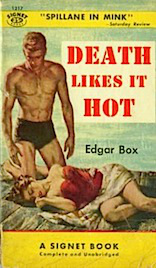 Moving to the idle rich on the other side of the Atlantic, another new player, Carol’s Notebook, brought us a review of Death Likes It Hot by Edgar Box (aka Gore Vidal).
Moving to the idle rich on the other side of the Atlantic, another new player, Carol’s Notebook, brought us a review of Death Likes It Hot by Edgar Box (aka Gore Vidal).
…a fun look at summer in the Hamptons in the 50s, in addition to being a decent mystery… Apparently, the mysteries were written after Vidal’s third literary novel, The City and the Pillar, about a homosexual love affair, was rejected by The New York Times on moral grounds. The Times also declined to review his next five novels.
From the Hamptons to Rhode Island (which are the same kind of place to my English mind). Bev at My Reader’s Block read Invitation to Murder by Leslie Ford, with trust-fund malarkey among the wealthy.
Fish (James Fisher) Finlay comes back from the Korean War minus a portion of his leg and missing a chunk of his self-esteem. He goes to work for the Merchants & Mechanics Bank and Deposit Company and earns enough respect from Caxson Reeves, Vice President, to be given a watching brief on the James V. Maloney Trust. As soon as he gets involved, he suspects that Nikki de Gradoff, fourth husband of Dodo Maloney, was scheming to gain possession of Dodo’s fortune. There are rumors that de Gradoff helped his previous wife to shuffle off this mortal coil.
From Rhode Island to Barry Island (or Wales, anyway). Kate at crossexaminingcrime reviewed Welcome Death by Glyn Daniel, which opens with a committee meeting in a Welsh village, and a well-drawn depiction of local life at the end of WWII.
However, as you have probably guessed there is the inevitable but. What lets this potentially great story down is the investigation of the crime. The narrative style begins to suffer becoming duller and the investigation itself feels like it is dragging on, which may be in part to the focus on alibis. Alibis are important but multiple conversations about a group of people’s alibis can get boring quite quickly and in some ways it feels like the investigators are going around in circles or digging over the same ground.
 Kate also read Sent To His Account by Eilís Dillon, in which a small-time accountant inherits a mansion, £40,000, a title, acres of land and ownership of many properties in the village of Dangan.
Kate also read Sent To His Account by Eilís Dillon, in which a small-time accountant inherits a mansion, £40,000, a title, acres of land and ownership of many properties in the village of Dangan.
By and large this novel puts forth the idea that the “old way” of doing things doesn’t have to be completely destroyed. It requires an able figure head and various social and economic reforms and revisions though. Miles quickly shows that he is the man for the job, being keen to do his best, partly because he feels he is obliged to, but also because he was ‘madly, despairingly in love with’ the place. Though it takes him a while to get over the feeling that he is ‘an interloper’. He also needs to see Dangan for what it is and to not view it through rose tinted spectacles if his plans for improvement are to succeed, as initially he sees Dangan as ‘a fairy village.’
 Henry Wade’s Gold Was Our Grave, a mix of classic puzzle and police procedural, was the second offering from new player Jason Half:
Henry Wade’s Gold Was Our Grave, a mix of classic puzzle and police procedural, was the second offering from new player Jason Half:
This story could have proven a dry exercise in puzzle plotting, its author content to push his characters around like chess pieces until the solution is revealed. Instead, Wade accomplishes more: he gives the reader a glimpse of believable inter-departmental case-building, with Poole using his colleagues and police contacts (including Chief-Inspector Lackett of C.6 division, specializing in fraud and financial crime, and Detective-Constable Riddling, Poole’s feet on the ground) to follow leads and scrutinize alibis. This group detective work invites the reader to appreciate the well-paced, cumulative experience; other “machinery of justice” resources here are similarly well-defined, from a communication with the American Federal Bureau of Investigation – looking into the provenance of a murder weapon bought in Chicago – to a perfectly observed solicitor for the defense who understands completely just how much he can hear from his client before legal (if not ethical) waters become muddied.
 A couple of legal titles now. Bev’s review of Murder on Trial, the debut novel by Michael Underwood, begins with a shooting right in the middle of the Old Bailey.
A couple of legal titles now. Bev’s review of Murder on Trial, the debut novel by Michael Underwood, begins with a shooting right in the middle of the Old Bailey.
But just before the shot, a young woman lets out a dreadful scream which draws the attention of the court. Apparently no one, including Inspector Manton, saw who shot Tarrant through the heart as he was making his way to the witness box. Why did Maisie Jenks scream out seconds before the gun went off? And why did a juror run out of the courtroom seconds after the victim lay dead on the floor? Who threw the gun down beside the lifeless body? Inspector Manton’s investigation of these very baffling circumstances provides a new and ingenious mystery that unfolds at a fast pace.
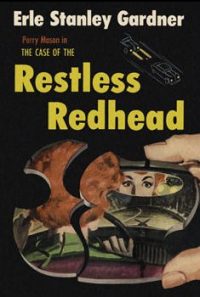 More law: Erle Stanley Gardner’s The Case of the Restless Redhead, in which his lawyer Perry Mason drops everything to defend a redhead accused of murder. This was apparently the story which inspired the first episode of the TV show.
More law: Erle Stanley Gardner’s The Case of the Restless Redhead, in which his lawyer Perry Mason drops everything to defend a redhead accused of murder. This was apparently the story which inspired the first episode of the TV show.
The story is fast-paced. The characters may be stereotypes but they are interesting characters regardless. The plot is intriguing, regardless of the inconsistencies.
You can read more at Bitter Tea and Mystery.
 John at Pretty Sinister Books was on a 1954 roll this month. He opened with E. B. Ronald’s The Cat and Fiddle Murders, featuring a British detective trying too hard to be an American hard-boiled PI.
John at Pretty Sinister Books was on a 1954 roll this month. He opened with E. B. Ronald’s The Cat and Fiddle Murders, featuring a British detective trying too hard to be an American hard-boiled PI.
He’s not an unlikeable guy this “Brad” Bradley nor is he incompetent as a detective. But nothing really distinguishes him from the dozens of private eye clones in the post WW2 era, either Brit or Yank. He peppers his speech with the usual smart aleck’s patois, he has a weakness for the ladies yet will insult the more forward of the loose women he meets, and he does yeoman work as a detective.
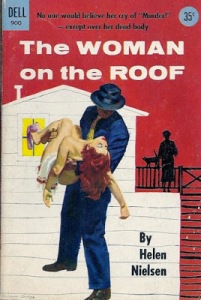 John followed up with Helen Nielsen’s The Woman on the Roof, a high-concept set-up which sounds far superior.
John followed up with Helen Nielsen’s The Woman on the Roof, a high-concept set-up which sounds far superior.
Wilma Rathjen spends a lot of time watching her neighbors from her rooftop apartment that overlooks the courtyard building next door. One night while spying through their open, well lit windows she sees a dead woman in a bathtub but says nothing about to anyone. Instead she does a lot to unwittingly implicate herself in what turns out to be a murder set up to look like a terrible accident. When Wilma herself is targetted by the killer who thinks she knows too much she flees making more foolish decisions and endangering others.
John’s third book was M. E. Chaber’s As Old As Cain.
This is a legitimate detective novel and not anything like the espionage adventure thrillers that make up the bulk of the Milo March series. From what I have read on other mystery websites and from the allusions to the two previous books in the series March is often sent to foreign countries often undercover to deal with insurance fraud. Here Milo assists the police with a murder investigation that also involves theft. The story is handled like a traditional detective novel with the usual discovery of physical evidence, the odd red herrings, and Q&A of the suspects.
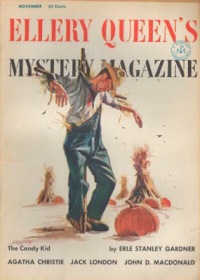 In a nice touch, John also looked at some shorts, in the November ’54 issue of Ellery Queen’s Mystery Magazine, which included…
In a nice touch, John also looked at some shorts, in the November ’54 issue of Ellery Queen’s Mystery Magazine, which included…
…The very first story by William Link and Richard Levinson, creators of Columbo and many other TV crime dramas and movies, when they were only 20 years old and still students at the University of Pennsylvania.
And tantalises us with an L. Frank Baum (of Wizard of Oz):
…a crime story rather than a detective story. It presents the life of a brazen bank teller with a gambling addiction and a taste for embezzlement who seeks out the help of a money lender to help him pay his debts and cover his “loans” from the cashier’s till. The unusual ending — especially for a story written in 1897 — probably made jaws drop. I’m sure the story was shocking and considered tasteless and immoral by Baum’s contemporaries.
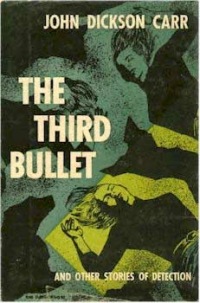
Some more short stories: JJ at The Invisible Event read The Third Bullet and Other Stories, a collection of seven tales by the master John Dickson Carr:
Only ‘The House in Goblin Wood’ is really essential, but for me any time spent with Carr is never truly wasted. As evidence of what can be done with an impossible setup, clearly-defined characters, a mostly well-hidden guilty party, a false solution, and then a fair-play genuine solution within 20 pages, however, it’s indispensable.
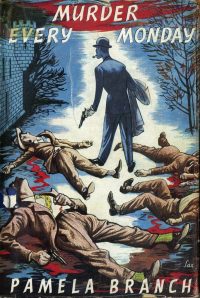 Bev returned to the fray with Murder Every Monday by Pamela Branch, which has a lovely set-up (and rather jolly cover – love the pipe).
Bev returned to the fray with Murder Every Monday by Pamela Branch, which has a lovely set-up (and rather jolly cover – love the pipe).
Clifford Flush is a founding member of the Asterisk Club–a club specifically for people who have been wrongfully acquitted of at least one murder. That’s right: sedate little Mrs. Barratt has disposed of two husbands; Colonel Quincey is an expert “hunter;” The Creaker has done such horrible deeds that even his fellow club members won’t let him “talk shop;” Miss Dina Parrish, club secretary, managed to lose her fiance off the edge of a cliff; and Clifford himself was once known as the Balliol Butcher.

Jose Ignacio submitted his review of Vertigo (aka D’Entre les Morts) by Pierre Boileau & Thomas Narcejac:
An intense psychological thriller very much to the taste of the time in which it was published. A bit pretentious in my view, it certainly is very well written. Although its pace may seem somewhat slow at first, it manages to keep the reader’s attention. I won’t hesitate to describe it as a literary thriller. And I particularly liked the contrast between the petty concerns of the characters and the tragedy that, during those times, loomed over Europe. All in all a dark tale that I’m convinced will delight the lovers of the genre.
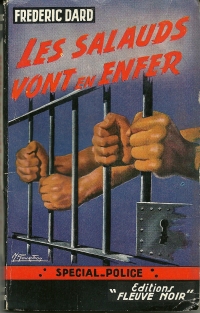 And a second French title was The Wicked Go to Hell by Frédéric Dard.
And a second French title was The Wicked Go to Hell by Frédéric Dard.
Dard wrote his most personal novels very much in line with ‘les romans durs’, of his admired Georges Simenon. It is therefore, a noir tale that attempts to deepen into the darkest corners of the human soul. This is a kind of literature that I very much like when it’s well done. And I do have the perception that Dard is a master of his craft. An author that is very much worth to follow. And that, if my information is correct, his best books are still to come.
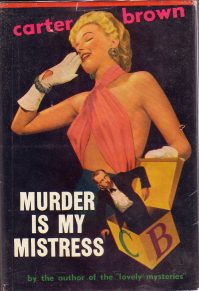 Scott at The Nick Carter & Carter Brown Blog read Murder Is My Mistress by Carter Brown. PI Julian Cross is hired to find the killer of a dog, but finds a human murder too:
Scott at The Nick Carter & Carter Brown Blog read Murder Is My Mistress by Carter Brown. PI Julian Cross is hired to find the killer of a dog, but finds a human murder too:
A bunch of screwballs they were. Sylvia Stamford, a silver blonde who never stopped acting when she left the stage. Johnny Zoan, an ex-racketeer. Theresa Boon, a sultry blonde with the beat of tom-toms in her voice. Juliet, a tall redhead and every inch of her a women. Jeff Peters, the guy people flattered when they call him a moron. Helen Mills, the girl with the horn-rimmed glasses with a burning need for a psychiatrist. And D’Aguerri, who was even more irritating as a memory than he had every been when he was alive.
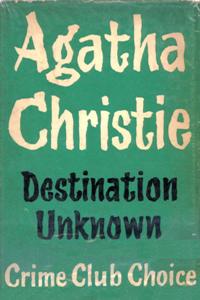 Poor old Brad at ahsweetmystery volunteered himself to read famous Agatha Christie clunker Destination Unknown.
Poor old Brad at ahsweetmystery volunteered himself to read famous Agatha Christie clunker Destination Unknown.
You take one scrappy heroine, send her off on an adventurous trip and have her cross paths with Bolsheviks, or white slavers, or Nazis and their ilk. Toss in some romance if you can, expose the ringleader of the bad guys in a moment of great surprise, and make the world safe again for King and country […] In this instance, we have a vague allusion to the Cold War and the possibility that the Soviet Union is causing some of the great scientific minds of the Western world to disappear. Is this true? If so, are the scientists defecting, or are they leaving without volition? Are they even alive? And what has happened to Thomas Betterton, the inventor of that crucial element, Ze Fission, without which England may not survive (although Christie forgets to tell us exactly what Ze Fission does.)
 Another dud: Moira at Clothes in Books found Patricia Wentworth’s The Benevent Treasure trailed off pretty quickly, despite a strong opening scene with a girl trapped on a cliff face and the inclusion of ‘extremely expert knitter’ Miss Silver.
Another dud: Moira at Clothes in Books found Patricia Wentworth’s The Benevent Treasure trailed off pretty quickly, despite a strong opening scene with a girl trapped on a cliff face and the inclusion of ‘extremely expert knitter’ Miss Silver.
As a book of 1954 there wasn’t much to offer – except for the charming fact that it became clear that the height of luxury and sophistication would be to have an electric bar heater or a gas fire in your bedroom or office, and you would be grateful for and impressed by such a thing – such items are mentioned three times.
 And a third dud. The Puzzle Doctor continued his quest to read Rhode with 1954’s Death on the Lawn, in which businessman Robert Thwaite is relaxing on his lawn when he is shot in the back by a bow and arrow. However:
And a third dud. The Puzzle Doctor continued his quest to read Rhode with 1954’s Death on the Lawn, in which businessman Robert Thwaite is relaxing on his lawn when he is shot in the back by a bow and arrow. However:
As soon as Superintendent Jimmy Waghorn turns up, most of the suspects fade into the background. It’s fair enough, as they had no opportunity to commit the crime, but Golden Age detective fiction isn’t really about realism. You expect that as soon as someone says that no woman would be strong enough to use the massive longbow, then the author will be looking for a cunning way for that to happen. But instead, once that fact is elucidated, then it just eliminates all the female characters from suspicion. Overall then, it’s a case of wasted potential here. A promising opening dovetails into too focussed an investigation and a thin motive for the murder.
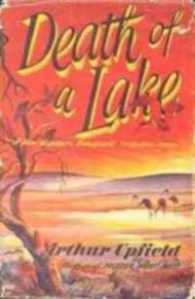 This one sounds better, Bernadette in her Fair Dinkum Crime blog covered Arthur Upfield’s Death of a Lake,
This one sounds better, Bernadette in her Fair Dinkum Crime blog covered Arthur Upfield’s Death of a Lake,
As with the previous two novels I’ve read it is Upfield’s depiction of the Australian setting that steals the show for me. This novel’s central place is a temporary inland lake: an area that has water for a year or three but which routinely dries up completely when the drought that is inevitable in Australia takes hold. Upfield’s lake is the fictional Lake Otway but it resembles real-life Lake Eyre which is, when it isn’t a dust bowl, is the largest lake in the country.
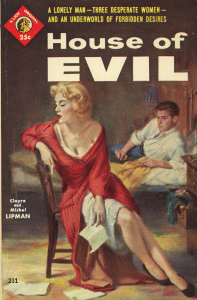 Time for some more pulp. Sergio at Tipping My Fedora took a shine to Clayre and Michael Lipman’s House of Evil:
Time for some more pulp. Sergio at Tipping My Fedora took a shine to Clayre and Michael Lipman’s House of Evil:
Told with imagination and more than a little flair, this is a clever story that also offers its readers a visit down the seamier streets of San Francisco. It may not be a forgotten classic … but this is an expertly plotted and very well told tale of psychological suspense that is almost as good as the mysteries being published by the likes of Robert Bloch and Margaret Millar at the time – which as far as I am concerned is very high praise indeed. What is especially memorable are the ‘Smith’ sequences in which we experience his fevered dreams and then his attempts to recreate them in paintings that are as bizarre as anything concocted by Francis Bacon and exert a fascinating power, giving this story a surprisingly visual edge and which is conveyed with great success by its authors, not otherwise especially well-known for their work in the genre.
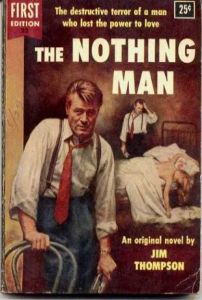 And JJ at The Invisible Event took in Jim Thompson’s The Nothing Man
And JJ at The Invisible Event took in Jim Thompson’s The Nothing Man
Thompson always excelled at psychology. If you find the “snobbery with violence” of the puzzle school too anodyne for your spirit to muster enthusiasm for, pick up a Jim Thompson book pretty much at random — excepting perhaps his debut, Now and on Earth (1942) — and watch a man (it was always a man with Thompson, though we shall get to his women shortly) crumble and crack and fracture apart as his mind eats itself while the external world either carries on blithely unaware or, as is more often the case, staggers and reels from the earthquake this sets off within it. The small casts, the small towns, the tight packing of geography, the inescapability of one’s actions, press and press and press inwards on these men, the external violence they mete out more than balanced by the slow awareness of dispossessed reasoning. And typically the only people who have any chance of understanding their predicaments — through being the people who are made aware of them in the first place — are the ones who end up dead.
Thanks to everyone who played, and apologies if I missed anyone out. Onwards and backwards to 1930…




Thanks for including me in this crop Rich – a great and fascinating look at 1954!
LikeLike
Great work again, Rich. Keep up the good work!
LikeLike
Thanks Rich for your excellent round-up, as always. Just a minor detail, before someone else points this out, The Wicked Go to Hell was published in 1956. But anyway thanks very much for your link.
LikeLike
Oh no! I like the cover though, so I’m leaving it in 🙂
LikeLike
Oh! I thought you liked my review 🙂
LikeLike
What a great collection. Thanks for including me.
LikeLike
No problem, thanks for playing 🙂
LikeLike
What a lot of books – and gotta love those covers!
LikeLiked by 1 person
Sterling work again, Rich, many thanks for continuing to wrangle this. Looking forward to 1930…
LikeLiked by 1 person
A longer list this time, it seems to me? And some very interesting books. I enjoy participating.
LikeLiked by 1 person
I state the absolute obvious, but glancing through a list of crime and mystery books arranged by their publishing year (this one landing more than 60 years ago), taking in all the newly discovered titles and images, and visiting the sites of the reviewers to learn more is really delightful. The next time I look out at my classroom of composition students with their heads drooped and their gazes locked on their little cellphone screens, I need to remember that the Internet also allows for positive community learning and inspiration to read more and communicate.
And then I’ll tell them to put the phones away.
Thanks for your efforts, Rich! —- Jason
LikeLiked by 1 person